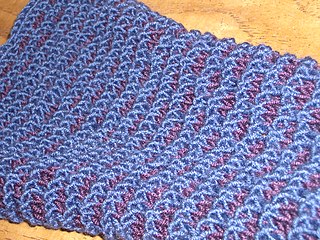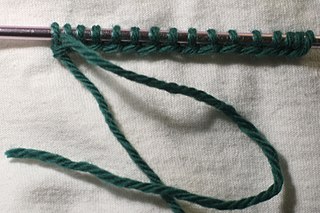
Knitting is a method for production of textile fabrics by interlacing yarn loops with loops of the same or other yarns. It is used to create many types of garments. Knitting may be done by hand or by machine.

A knitting needle or knitting pin is a tool in hand-knitting to produce knitted fabrics. They generally have a long shaft and taper at their end, but they are not nearly as sharp as sewing needles. Their purpose is two-fold. The long shaft holds the active (unsecured) stitches of the fabric, to prevent them from unravelling, whereas the tapered ends are used to form new stitches. Most commonly, a new stitch is formed by inserting the tapered end through an active stitch, catching a loop of fresh yarn and drawing it through the stitch; this secures the initial stitch and forms a new active stitch in its place. In specialized forms of knitting the needle may be passed between active stitches being held on another needle, or indeed between/through inactive stitches that have been knit previously.

A lockstitch is the most common mechanical stitch made by a sewing machine. The term "single needle stitching", often found on dress shirt labels, refers to lockstitch.

Circular knitting or knitting in the round is a form of knitting that creates a seamless tube. Work in the round is begun by casting on stitches as for flat knitting but then joining the ends of that row of stitches to form a circle. Knitting is worked in rounds, which forms the tube by winding around in a helix.

In everyday language, a stitch in the context of embroidery or hand-sewing is defined as the movement of the embroidery needle from the back of the fibre to the front side and back to the back side. The thread stroke on the front side produced by this is also called stitch. In the context of embroidery, an embroidery stitch means one or more stitches that are always executed in the same way, forming a figure. Embroidery stitches are also called stitches for short.
Intarsia is a knitting technique used to create patterns with multiple colours. As with the woodworking technique of the same name, fields of different colours and materials appear to be inlaid in one another, fit together like a jigsaw puzzle.

A knitting machine is a device used to create knitted fabrics in a semi or fully automated fashion. There are numerous types of knitting machines, ranging from simple spool or board templates with no moving parts to highly complex mechanisms controlled by electronics. All, however, produce various types of knitted fabrics, usually either flat or tubular, and of varying degrees of complexity. Pattern stitches can be selected by hand manipulation of the needles, push-buttons and dials, mechanical punch cards, or electronic pattern reading devices and computers.

Cable knitting is a style of knitting in which textures of crossing layers are achieved by permuting stitches. For example, given four stitches appearing on the needle in the order ABCD, one might cross the first two the next two, so that in subsequent rows those stitches appear in the new order CDAB.

Slip-stitch knitting is a family of knitting techniques that uses slip stitches to make multiple fabrics simultaneously, to make extra-long stitches, and/or to carry over colors from an earlier row.

In knitting, an increase is the creation of one or more new stitches, which may be done by various methods that create distinctive effects in the fabric. Most knitting increases either lean towards the left or the right.

In knitting, casting on is a family of techniques for adding new stitches that do not depend on earlier stitches, i.e., having an independent lower edge. In principle, it is the opposite of binding off, but the techniques involved are generally unrelated.
In knitting, binding off, or casting off, is a family of techniques for ending a column of stitches. Binding off is typically used to define the final edge of a knitted fabric, although it may also be used in other contexts, e.g., in making button holes. In principle, binding off is the opposite of casting on, but the techniques are generally not mirror images of one another. Sometimes, however, they can produce a mirror image appearance.

In knitting, a short row is a row that is not fully knitted; the work is turned before reaching the end of the row. When working short rows, technique must be employed to prevent holes or gaps where the work is turned. There are several ways to do this. Among the most common are (1) Wrap and Turn, (2) German short rows and (3) Japanese short rows.
Basic knitted fabrics include stocking stitch, reverse stocking stitch, garter stitch, seed stitch, faggoting, and tricot. In some cases, these fabrics appear differently on the right side than on the wrong side.

Knitted fabric is a textile that results from knitting, the process of inter-looping of yarns or inter-meshing of loops. Its properties are distinct from woven fabric in that it is more flexible and can be more readily constructed into smaller pieces, making it ideal for socks and hats.
Complete garment knitting is a next-generation form of fully fashioned knitting that adds the capability of making a 3-dimensional full garment. Unlike other fully fashioned knitting, where the shaped pieces must still be sewn together, finished complete knitted garments do not have seams. The knitting machines' computerized instructions direct movement of hundreds of needles to construct and connect several tubular knitted forms to create a complete garment in a single production step.
Hand knitting is a form of knitting, in which the knitted fabric is produced by hand using needles.

Cowichan knitting is a form of knitting characteristic of the Cowichan people of southeastern Vancouver Island, British Columbia. The distinctively patterned, heavy-knit Cowichan sweaters, popular among British Columbians and tourists, are produced using this method. Cowichan knitting is an acculturated art form, a combination of European textile techniques and Salish spinning and weaving methods. From this union, new tools, techniques and designs developed over the years.
In knitting, the three needle bindoff is a method of joining two pieces of knitted fabric using three needles. One needle is on each piece of the fabric, and a third needle is used for the knitting.

Pin weaving is a form of small-scale weaving traditionally done on a frame made of pins; the warp and weft are wrapped around the pins. Pin-woven textiles have a selvage edge all the way around.















